Snowmageddon
/ Snowpocalypse / SnowJam in Atlanta on January 2014
Suzanna
Travels no where: 21 hours to get home!
This is one event from my
Fun / Crazy Events page.

What absolutely nobody was calling it, I can assure
you, was Leon. ÂÂÂÂÂÂ
This despite the very best efforts of The Weather Channel,
which for some reason last year decided it should proactively name winter
storms. ÂÂÂÂÂÂ
For this year s list it had some added help: Students in a
Bozeman, Mont., high school Latin class came up with storm names drawn primarily
from the pages of mythology.
2.6 inches of afternoon snow turns into:
Aparkalypse 2014
Snowpeless
Snowpocalypse
Carmageddon
Stall-mate
CARnage
Implowsion 2014 Snow Snafu
Slow-slog Snowjam
Snowzilla
Gridlockalypse Or there's the shorter, more Southern
version: GritslockÂÂÂÂÂÂ
This is how I spent the night on Tuesday, January 28, 2014:
21 hours to get home
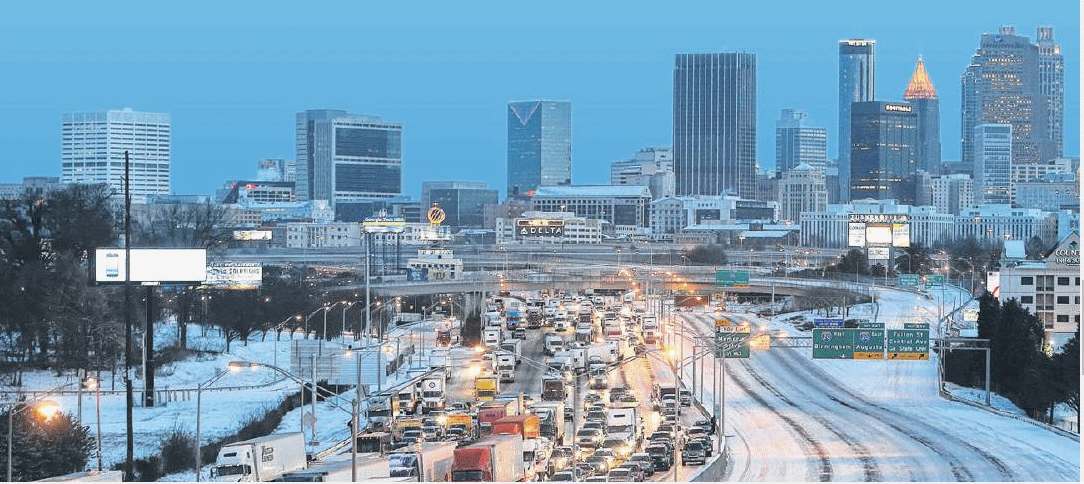
I leave work at 5:30.
Six (6) hours later I had only driven ("slid" is a
more accurate word) 5 miles down the road.
Judy and
Charlene called on my cell phone to let me know about open businesses helping stranded drivers.
I
was low on gas, I pulled into the Publix parking lot. There were cars
everywhere.
I found a space to "park". Kill the engine, grab my
coat and get out.
There was so much ice in the
parking lot, my car started to slide towards a pickup truck.
It was like a slow motion movie that you knew was
not going to have a good ending.
Voila! Inches to spare, the SLIDE ended. Cars
were not scratched, dented or merged.
I carefully walked to
the OK Cafe. We could sit and rest, but most important: use the bathrooms.
I stayed all night.
I had a soft booth under the money tree.
I was comfortable and warm. I slept off and on,
about 5 hours.
I woke up and all I saw was money! And it wasn't a dream!
Everyone was so nice. Sharing information, stories.
We could see multiple cars being loaded onto carriers
on the I-75 highway.
At noon we heard they were going to
open the hiway for a couple hours. At 12:30 I walked out to
my car.
I flagged down the guy on an ATV. I paid him $50 to
put 5 gallons of gas in my car.
Then came the
scariest part: start the engine and drive.
The on-ramp to
I-75 was clear, I actually had a speed limit (55 MPH) drive on I-75.
The Cumberland Blvd exit
was jammed with stopped, wrecked, immoble cars that could not get up the hill.
I kept driving.
Same with Windy Hill exit. Too many
cars. Impossible to get to the road. Keep driving.
I kept driving
past those exits up to Delk Rd. Exit
Delk. Good decision. No problem on the exit ramp (one navicable lane).
I dodged cars, zig-zagged around stopped, vacated, wrecked cars.
Cars on the ditch. Cars perpendicular across the
road. Drivers no where to be found.
I finally made
it to Austell Rd. Drive to Hurt Rd, but I was too scared to drive on Hurt Road.
I parked and walked the last mile to my house.
Finally! Exhausted. Collapse.
Next morning, some ice,
ok to drive. Finally car and me are home safe and sound. What
an experience!
This is
what the Governor was doing that day:


This is where I spent the night in this booth:
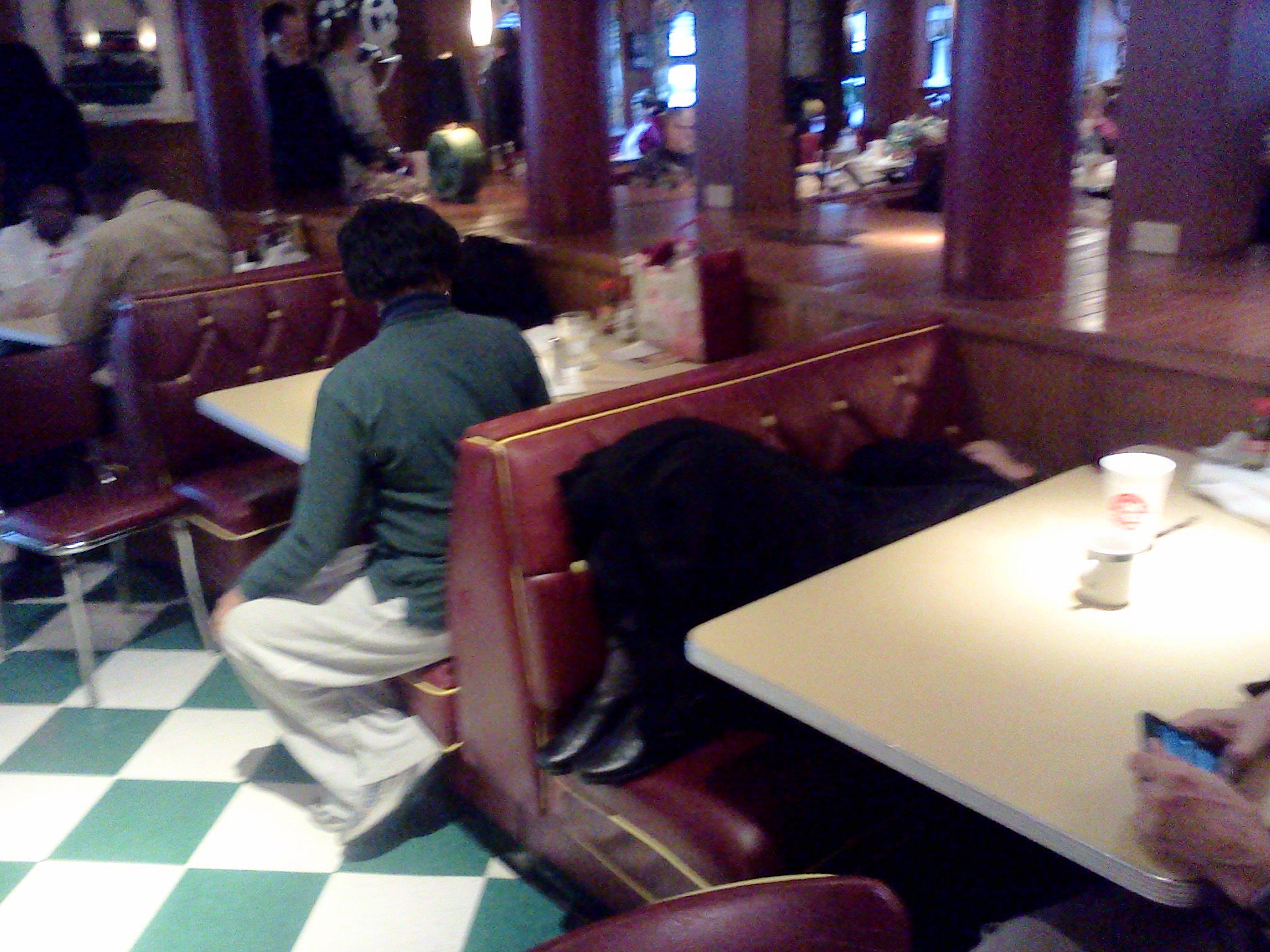
I stayed all night.
I had a soft booth under the money tree. I was comfortable and warm and slept
about 5 hours.
I woke up and saw all that money and it wasn't a dream!

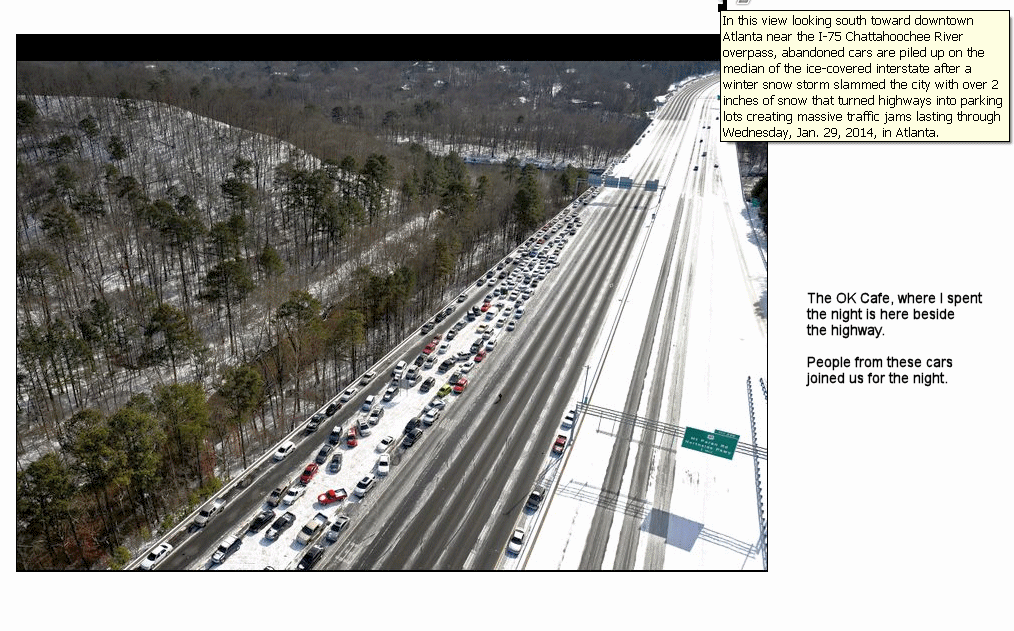
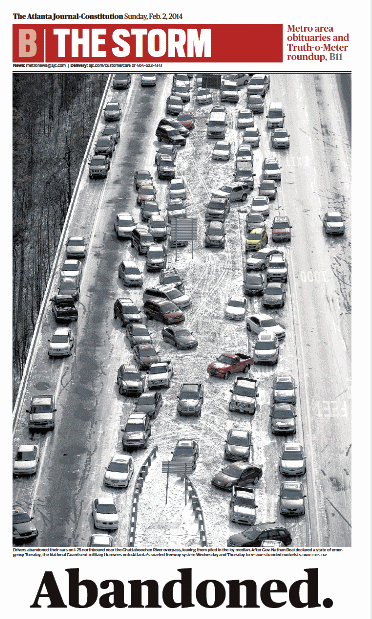
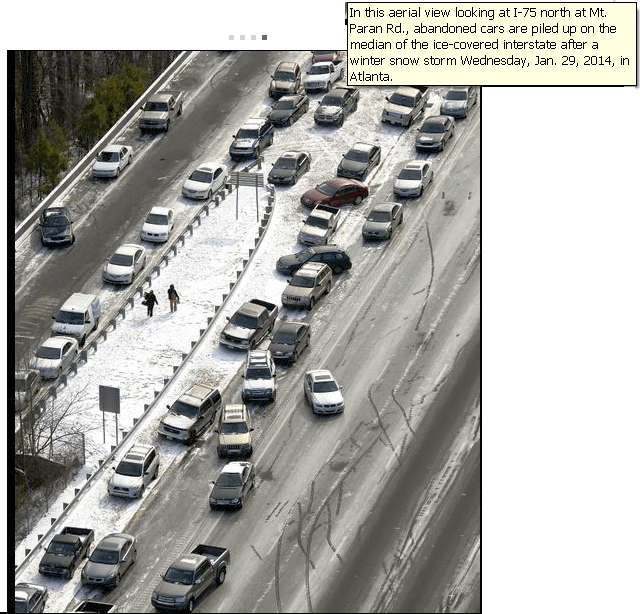
This CVS store was in the same shopping center as the OK Cafe where I spent
the night.
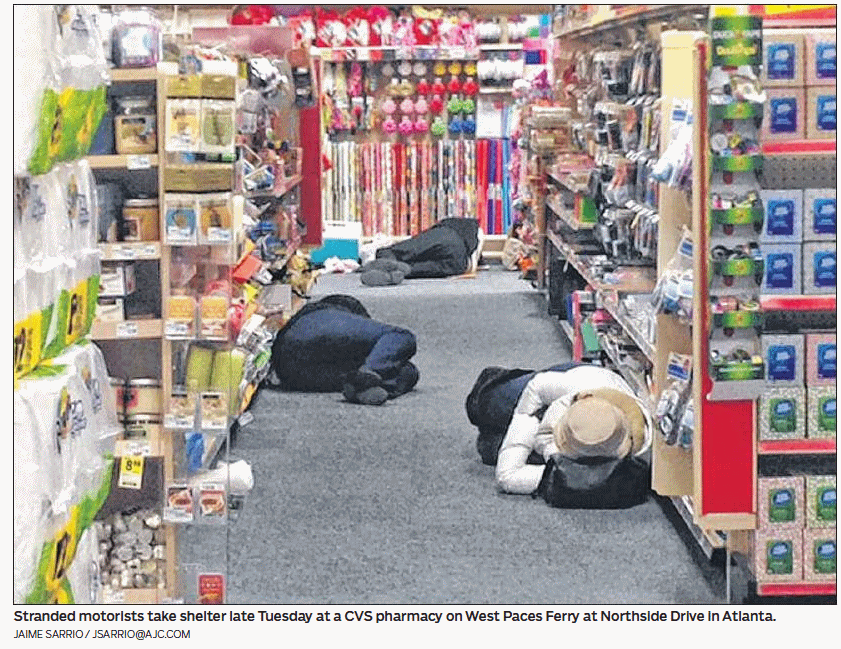
We watched this guy refill his gas can many times at
the station across from the OK Cafe.
I paid $50 for 5 gallons of gas, so I could get
home.
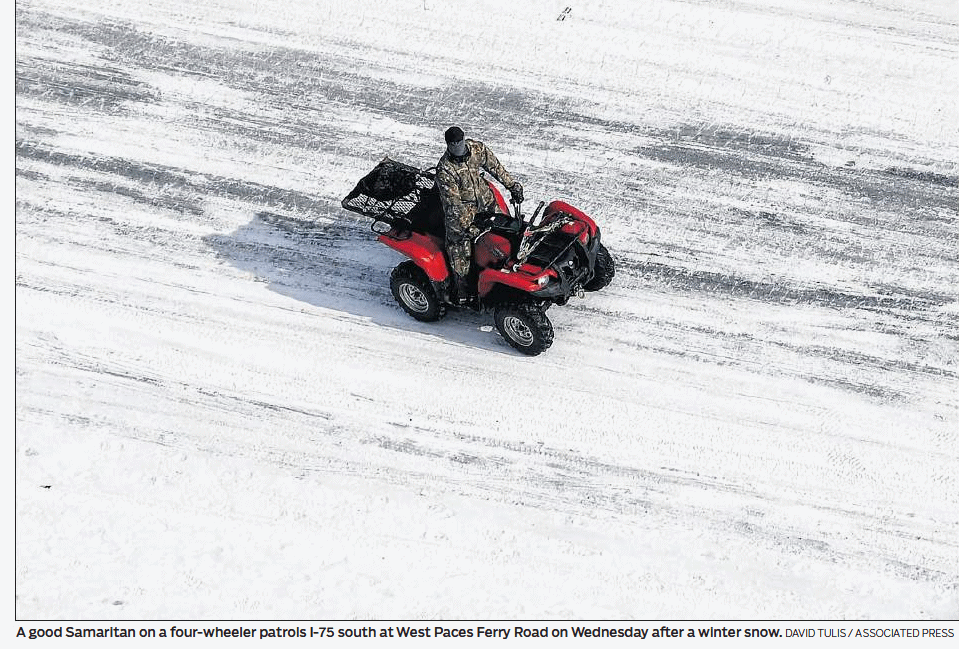
Back to Top
Nearly 3,500 children across metro Atlanta were stranded in shelters
Tuesday because they couldn t get home, and their parents had no way to retrieve
them.
Total number of residences and businesses in Georgia without power
late Feb 13: about 262,000
Total number of residences and businesses
without power at peak: 383,000
Estimated number of vehicles abandonded
during the storm: 2000
Estimate of the total number of people affected by the outages: 1.6 million
Total number of residences and businesses
affected by the power outage: more than 850,000
Storm was Tuesday. As of
Friday, 100,000 remained without power.
In the blizzard of 1993, 319,000
without power and it took 7 days to retore.
2 storm-related deaths
Feb 13, Thursday: More than 140 priority roadsand 100 priority bridges
had been treated for snow and ice as of Thursday afternoon,
with 25 bridges and
more than 50 routes receiving a second treatment.
Nearly 90 of those roadways
and bridges were plowed by midday.
Back to Top
The Atlanta Journal-Constitution, Saturday, February 01, 2014; Section:
Front Page, Page: A1
Reed defends his ride to interview as city idled
By Katie Leslie kleslie@ajc.com
For thousands of motorists who left
downtown Atlanta Tuesday evening, traveling I-75 to the city limits took nearly
a day.
For Mayor Kasim Reed and his support team, the drive was
considerably shorter.
Hours before Reed would stand at a press conference
with Gov. Nathan Deal to address a winter storm crisis, the mayor and a handful
of staffers used emergency lanes to cruise to an interview with The Weather
Channel, located just off the heart of the worst congestion at I-75 and I-285.
Reed spoke for about five minutes on the air. The quarter hour in which he
appeared drew an average audience of 456,000 viewers, according to the network.
Rafael Garcia was among those idling on I-75 when Reed s crew passed by. By
that time, Garcia had been on the road four hours and would have eight to go
before arriving home to Woodstock.
I think it's adding insult to a bad
situation. The more I thought about this, the more upset I get in every
respect,  said Garcia, who abandoned his car on the side of I-75 after it lost
traction on the slippery roads. He hitched a ride with a stranger. And when he
returned the next day to retrieve his car, it was gone, sending him on another
odyssey to find it.
Garcia, who moved to Atlanta in 1984, was furious at
what he sees as a lack of preparation for the storm from regional and state
leaders.
Reed acknowledged Snow Jam 2014 cost him political damage but
said, "I don't care about that. I care about the people being harmed. "
Y'all hear the one about Atlanta?
Our pain has become big gain for
late-night comics.
ByJill Vejnoska jvejnoska@ajc.com
Snow joking
matter?
Snow what? The lords of late-night TV comedy weren t about to let
metro Atlanta get away completely unscathed from one of the worst weeks in its
history that didn t involve Gen. Sherman and a book of matches. The jokes
crowded the airwaves like cars on I-285 during Gridlockalypse 2014.
Some
wisecracks were about as weak as one of those unfortunate drivers trapped for 15
hours in a vehicle with nothing to eat and nowhere to pee.
Luckily, Jon
Stewart could be counted on to come through as reliably as an ATV-riding Chipper
Jones rescuing Freddie Freeman from the storm. The host of The Daily Show  on
Comedy Central devoted a five-minute Thursday segment title: South Parked
ÂÂÂÂÂÂ
to hilariously poking holes in our elected officials claims that the storm had
taken the metro area by surprise. He didn t let us unelected folks off the hook
entirely, either.
I know the last time anyone in Atlanta carpooled was
this,  Stewart said, with a clip of Morgan Freeman s character chauffeuring
Jessica Tandy in Driving Miss Daisy  flashing onscreen. But this was an
emergency! ÂÂÂÂÂÂ
Here's some of this week s other late-night laugh lines,
along with links for watching:.
Jimmy Kimmel, Jimmy Kimmel Live, ABC.
www.youtube.com/ watch?v=86l0IwsP6Lw
º One woman tweeted a photo of a
group of people sleeping in a Home Depot. You know what they usually call it
when you see someone sleeping in Home Depot? An employee. ÂÂÂÂÂÂ
Jay Leno, The Tonight Show,  NBC.
www.nbc.com/the-tonight-show/video/monologue-part-1/n45739
Back to Top
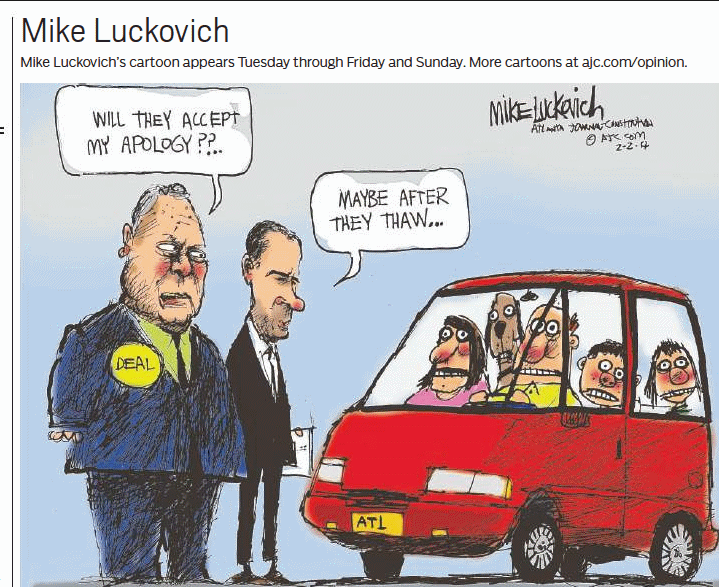
Back to Top
Surviving slow-slog Snowjam
A few insights gained from enduring a
13-hour commute home.
Personal reflections on this week s traffic
nightmare By Jennifer Brett jbrett@ajc.com
A guy marching up 285 in
University of Michigan pajama bottoms, shouting commands at dawn, was the only
authority figure I saw during our 13-hour commute home Tuesday night/ Wednesday
morning.
TAKE COBB PARKWAY!  We obeyed and finally got home.
Thanks, Michigan Man. Thanks for nothing, everyone whose job it is to deal with
traffic and weather calamities. Gov. Nathan Deal at first called the state s
response reasonable,  then later apologized and promised better response to
future storms.
We have learned some things from this last ice storm. We
are going to make sure that those lessons are implemented in terms of
preparation for future such events,  Deal said this week. Oh wait. He actually
said that three years ago, following the January 2011 snow and ice event that,
then as now, paralyzed Atlanta for days.
Charley English, director of the
Georgia Emergency Management Agency, engaged in similar backpedaling this week. In this particular event, if we played it exactly the same again, I would have
made the same decisions,  he said initially. By Thursday he had fallen on his
sword, saying I made a terrible error in judgment,  and promising that In the
future you can rest assured that when the forecasts change, there will be a much
more aggressive response. ÂÂÂÂÂÂ
Just before dawn, I went on air with my
colleague Scott Slade, host of Atlanta s Morning News on WSB. (The station and
The Atlanta Journal-Constitution, along with Channel 2, are all Cox Media Group
properties.) I usually write about movies,  I said during my call-in. Today
I m starring in one, called ËœDude, Where s My Car? Sitting on 285.
ÂÂÂÂÂÂ
This
was 10 hours into our odyssey, and we had yet to clap eyes on any emergency
vehicle. Shortly before I left the office, I heard an interview with a Georgia
Department of Transportation spokeswoman on Channel 2 Action News. The
spokeswoman told Channel 2 s Lori Geary that GDOT had learned from snowmageddons
past, and her quote was something like, We ve been waiting three years to show
how ready we are.  As I signed off with Scott, I wondered if it would take us
three more to get home.
Just then, Mr. Michigan appeared, hollering about
Cobb Parkway. Once we got there, our fortunes improved. Unlike 285, it was well
sanded, although littered with abandoned cars. Before long, the sight of
Marietta s favorite landmark, the Big Chicken, literally brought tears to my
eyes. In a few more minutes, we were home. Thirteen hours after we left.
So, what have I learned? Do not count on emergency assistance. Never did we ever
see a single public safety official. Certainly no one from GDOT, which,
remember, has been waiting three years to show everyone how ready they were. Mr.
Michigan was the only one who came through for us.
Back to Top
RECIPE FOR DISASTER
Evacuation: When no one led, no one moved
Storm s gridlock raises concerns about emergency response.
By Johnny
Edwards, Dan Chapman and Shannon McCaffrey
Last week s snowstorm laid
bare a $32.6 million state emergency management system incapable of dealing with
a run-of-the mill weather event, much less a major disaster. Power to trigger
that system rests with the governor, who waited hours to act. The same type of
weather event has paralyzed the region time and again.
Since Tuesday s
snow storm, Atlanta Journal-Constitution reporters have been grilling public
officials and poring through government documents, seeking answers as to why 2.6
inches of snow brought metro Atlanta to a standstill. For this story, a team of
reporters interviewed state officials, county leaders, local police chiefs,
emergency management experts and drivers who suffered through the traffic
crisis. The reporters found that, ultimately, a failure at the highest levels of
state government was to blame.
On Tuesday morning, Gov. Nathan Deal
attended a tourism event at the state Capitol as weather-related crashes were
being reported in northeast Georgia. Gov. Nathan Deal and Atlanta Mayor Kasim
Reed attend a luncheon at the Ritz Carlton in Atlanta honoring Reed. Outside the
luxury hotel, snow was beginning to fall.
Gov. Nathan Deal s delay in
taking charge during Tuesday s snow catastrophe triggered a series of cascading
failures, leaving hundreds of thousands of motorists abandoned and desperate for
food, water and shelter.
With no one at the helm, dozens of local
agencies took their own myopic approaches, barely communicating with each other,
much less the imperiled public.
The state s multi-million dollar
electronic sign system flashed useless messages at trapped drivers. The state s
mobile app, which is supposed to give up-to-the-minute updates on road
conditions, gave wrong information about road clearing. Police stood by as cars
blocked intersections. Calls to 911 were answered by an automated all circuits
are busy  message.
Consider it metro Atlanta s slap in the face: Last
week s snowstorm laid bare a $32.6 million state emergency management system
incapable of dealing with a run-of-the mill weather event, much less a major
disaster. Power to trigger that system rests with the governor, who waited hours
to act. No one else has both the legal and political muscle to take control.
Deal well knows what ice can do to Atlanta. He was inaugurated in a
crippling ice storm in 2011, and the first executive order he signed declared a
state of emergency for that storm. But state-level leaders failed to plan
adequately for the same type of weather event that has paralyzed the region time
and again.
Yet the governor would not sign a state of emergency until
more than five hours later. By then, many were begging for someone to take
command.
The increasing balkanization of the 10-county metro area no
doubt compounded Tuesday s mess. Ninety locally elected governments, with more
on the drawing board, make it nearly impossible to effectively plan for a
region-wide emergency, let alone react once a storm hits, critics say.
It s a regional problem. No one has taken a regional solution to solve it, ÂÂÂÂÂÂ
said Bill Byrne, former Cobb County Commission chairman.
Back to Top
Journal-Constitution, Sunday, February 02, 2014; Section: Front Page,
Page: A1
On own, drivers and teachers turn heroes
Frontline educators
were left to make big decisions by selves.
By Carrie Teegardin
cteegardin@ajc.com and Ty Tagami ttagami@ajc.com
Metro school
superintendents blamed the weather forecast, the suddenness of the storm and,
occasionally, themselves for Tuesday s disaster of abandoned buses and stranded
children. Culled from statements issued or comments uttered last week:
Jay Dillon, Cobb County schools spokesman
From an email to the AJC
Wednesday: Based on the weather reports and other information we had late Monday
night and into Tuesday morning, there was no reason for us to believe that a
major weather event would impact the northern Atlanta suburbs the way it did...
. Had the forecasts suggested that would take place, we would have canceled
school.
Alvin Wilbanks, Gwinnett
From an interview Thursday: We
were discussing 4 a.m. in the morning [Tuesday] about the day, and we decided
according to all reports we could get, we could get a day of school in... . The
overwhelming majority of our students were home on time  [Gwinnett had
comparatively few problems on Tuesday, as did DeKalb.]
Stuart Gulley,
president, Woodward Academy
Letter to school community Wednesday: I
apologize. Words cannot express fully the deep regret I feel for the
unimaginable horror so many members of our community experienced yesterday in
their commute home. Hindsight is always much clearer, and from that perspective
the decision to release at 1:40, even to have conducted school at all, was
wrong... . We have (and will) learn lessons from yesterday s episode.
Lin-Sheng Lee still had seven teenagers on his bus when he got stranded.
Little heat on the bus. Eighteen degrees outside. Stuck in the dark on the
on-ramp from Ashford-Dunwoody to I-285: no cops, no rescue, no options.
Three hours come and go. About 10:30 p.m., three young people emerge from the
dark and tap on the bus door. We have food,  they say. Lee replies, Oh my God ÂÂÂÂÂÂ
and gratefully accepts the candy bars and water.
Midnight: still no
rescue. The kids are tired, hungry and desperate for a bathroom. The cold is
just getting worse.
School districts in metro Atlanta made the
spectacularly bad decision to open on Tuesday a fateful call that meant the
central offices were disconnected from key decisions made Tuesday evening.
Instead, life-and-death decisions about children fell to people like Lin-Sheng
Lee the bus drivers, principals, teachers and school staff, all pushed into
impossible and sometimes terrifying quests to return students to their families.
That no children died or were even seriously hurt is testament to the caring
and resourcefulness of those frontline workers and reflects no small amount of
luck. TEN THOUSAND children in Atlanta, Fulton, Cobb, Cherokee, Douglas and
Marietta had not made it home as of 9 p.m. Tuesday. At Marietta High School,
culinary arts students took to the kitchen and cooked for stranded classmates.
Contrast that with Atlanta, where cooks at the city jail prepared food for some
of the stranded kids and police delivered it. Scores of buses, including about
80 in Atlanta alone, were abandoned on the roads.
The driver stayed with
him all night.
The number of children stranded was highest in Fulton
County: 3,145, of which 239 spent the night on buses. At south Fulton s Westlake
High School, cafeteria manager Henry Smith made it home but then decided to walk
back to school in the snow. He prepared 800 dinners and then 450 breakfasts.
In North Fulton, Centennial High normally has 50 buses. On Tuesday, only
five made it to the school. Some drivers struggled through traffic even to get
to the bus yard. Then it took them hours to get to the school, if they made it
at all. At one point, administrators decided to allow some kids to walk home.
The few buses that did arrive packed students on, even those not on their
regular routes, and tried to get them as close to their homes as possible.
But there were still more kids than bus seats, and it became clear that some
students would not make it home. That included close to 30 special-needs
students. Some in wheelchairs. Some with medication needs. Others with special
diets.
Teachers and staff took sheets and blankets from the school s
health care occupation program and sanitized gym mats so the students would have
a place to sleep. They walked through the snow to pick up 50 pizzas at a nearby
shop that was open. They also trekked to a nearby Kroger to collect emergency
prescriptions.
When cell phone service was not jammed, the staff called
parents to check in and texted photos home to give some comfort.
I
know how these parents feel,  said Diane Nadler, a paraprofessional who works
with special needs kids and chose to stay the night to help. I d do what I want
someone to do for my child. ÂÂÂÂÂÂ
Having to figure it out on our own.
Teachers and drivers with children in their care figured out solutions on
the fly wherever they found themselves. The hard part, for some, was the sense
that they had no backup, no matter how bad things got.
Around midnight,
Lin-Sheng Lee got another knock on his bus door. It was the same three youths
who had brought snacks hours earlier, back with more food.
Soon, Lee got
the call he d been waiting for: the DeKalb County police were nearby.
They couldn t reach the bus, and he was instructed to walk with his charges back
up the ramp. Up they trudged. Lee, 65, was worried until he saw the flashing
blue lights. The best part of the rescue, he said, was that the car was warm.
ÂÂÂÂÂÂ
The police took them to the school district police headquarters on Memorial
Drive, where they got meals and rest. Then, Lee accompanied the police to direct
them to the teenagers homes. He didn t get them home on the bus, but he got
them home. The ordeal ended after daybreak.
Lee said people thanked him
for staying with the kids, but he said he was just doing his job. He was just
thankful to the three youths who appeared bearing food. Those persons really
nice,  he said, because that s not their job.
ÂÂÂÂÂÂ
Officials already
faced instant criticism of not canceling school in the first place. Now in a
system where 75 percent of students ride the bus, officials were telling parents “ many of whom were stuck in gridlock “ they had to come pick up their children
at school.
At 4 p.m. nearly 5,000 of the district s 8,800 students were
still at school, and administrators were told to begin preparations to, as the
emergency plans call it, shelter in place. ÂÂÂÂÂÂ
We knew there would be
parents who would be very, very upset that we could not deliver their children, ÂÂÂÂÂÂ
Marietta Superintendent Emily Lembeck said. We had absolute heroes working in
our schools. ÂÂÂÂÂÂ
At 6 p.m. Hickory Hills Elementary principal Kristen
Beaudin still had about 250 of her school s 487 students. While teachers began
cooking spaghetti for the students-turned-refugees, Beaudin started calling
nearby parents for help.
Within hours the school had so many blankets and
pillows that some were sent to comfort students at other schools. Area families,
including Marietta s mayor and a former school board member, brought hot dishes
of food for students and teachers.
A parent with a 4-wheel-drive Jeep
ferried children down an icy slope from the school to parents waiting a few
blocks away. A cache of about 100 donated jackets were distributed to children
not dressed for the rugged weather.
I've never been more honored to be
the principal of Hickory Hills,  Beaudin said.
Across town at Marietta
High School, students in the culinary arts program served dinner to about 700
stranded students and staff.
They need a little rest as well, but . . .
Teachers did everything they could think of to keep children
comfortable.
Back to Top
Journal-Constitution, Saturday, February 15, 2014; Section: World &
Nation, Page: A4
Winter-weary Northeast hit again
Up to 22 inches in
Pennsylvania; South waits for power.
By Kathy Matheson and MaryClaire
Dale Associated Press
Pennsylvanians were coping with the aftermath of a
major winter storm Friday, digging out from a deep coating of fresh snow while
many businesses and schools remained shuttered. More snow was in the forecast.
The National Weather Service said the state s deepest snow was recorded in
the Bedford-Somerset county area, where up to 22 inches fell. More than 20
inches fell in parts of Chester County, west of Philadelphia
Major
roadways were generally clear, but there were slick conditions. Two major
pileups and smaller fender-benders involving tractor-trailers and scores of cars
blocked one side of an ice-coated Pennsylvania Turnpike outside Philadelphia,
injuring at least 30 people and tying up traffic for hours. The pileup occurred
just two hours after the turnpike canceled weather-related speed limits.
In the South, the longest-lasting effect of this weeks ice and snow storm
was power.
About 1.2 million utility customers from the South to
Northeast lost power at some point. That dramatically dropped to about 465,000
outages by Friday morning, mostly in South Carolina and Georgia. The numbers did
keep dropping, but life without electricity after a third day was becoming a
hassle.
With roads finally thawed out, many in the hardest hit areas were
able to finally leave their homes. But there weren t too many places to go. Few
stores were open because they didn t have power, either.
Back to Top
Nearly 3,500 children across metro Atlanta were stranded in shelters
Tuesday because they couldn t get home, and their parents had no way to retrieve
them.
Total number of residences and businesses in Georgia without power
late Feb 13: about 262,000
Total number of residences and businesses
without power at peak: 383,000
Estimated number of vehicles abandonded
during the storm: 2000
Estimate of the total number of people affected by the outages: 1.6 million
Total number of residences and businesses
affected by the power outage: more than 850,000
Storm was Tuesday. As of
Friday, 100,000 remained without power.
In the blizzard of 1993, 319,000
without power and it took 7 days to retore.
2 storm-related deaths
Feb 13, Thursday: More than 140 priority roadsand 100 priority bridges
had been treated for snow and ice as of Thursday afternoon,
with 25 bridges and
more than 50 routes receiving a second treatment.
Nearly 90 of those roadways
and bridges were plowed by midday.
Back to Top
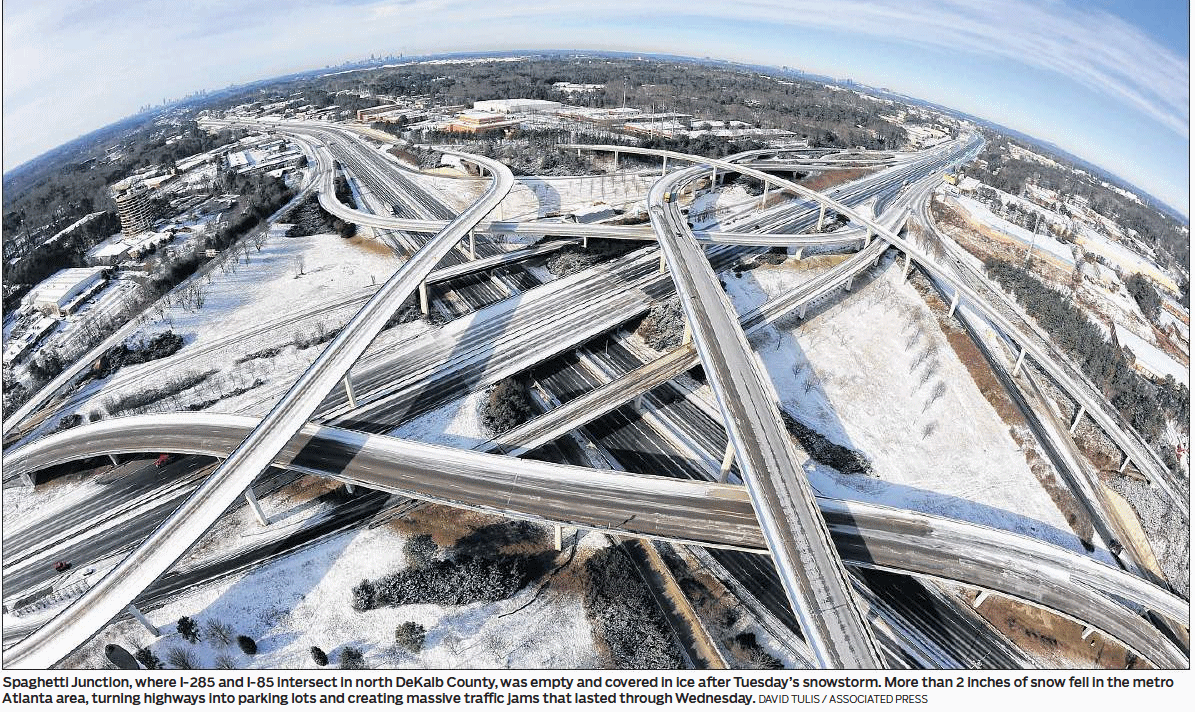

This page and all other pages in the
http://www.mytrips.com web site, along with the journals, images, and photos are Copyright ©
2025 by Suzanna Travels. All publication rights are reserved. Email: web@
mytrips.com Remove the space after the @












